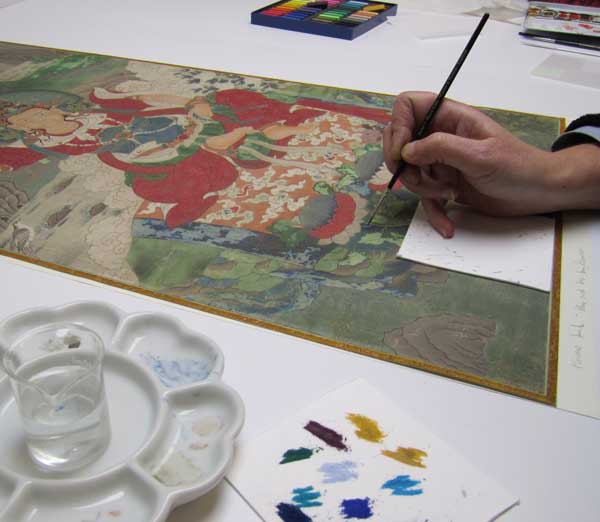Nuns from Kathmandu help restore 400-year-old Tibetan paintings
The works are now on view at the Museum of Fine Arts, Boston.

Conservation work was done on the paintings themselves. Here, a conservator is inpainting areas of pigment loss
Conservators from the Museum of Fine Arts, Boston called upon the services of nuns from Kathmandu, as well as Tibetan and Taiwanese specialists in silk brocades and Japanese fabricators of gilt-bronze decorative ornaments for an ambitious, two-year project to restore a series of 400-year-old thangkas or Tibetan paintings. The works, which depict the kings of the utopian realm of Shambhala, also known as Shangri-la, form part of the exhibition “Seeking Shambhala” on view at the museum until 21 October.
The project sought to return the 23 thangkas to their traditional format as hanging scrolls. The works were stripped of their decorative textile mounts and placed on panels prior to entering the museum’s collection in 1906 as a gift of the collector, museum trustee and Harvard University professor Denman Waldo Ross. “They had been ripped from their original frames and looked dead,” says Jacki Elgar, the head of the museum’s Asian conservation department. “These painting were supposed to be bathed in lavish, colourful textiles to celebrate these deities,” Elgar says, adding that the beige Indian silk that replaced the original textile mounts made the paintings look “drab”.
A team of conservators spent around 4,000 hours on the project using materials sourced from far-flung corners of the world. “It was a truly global initiative,” says Elgar. “We wanted the mounts to be as authentic as possible.” Elgar and her team turned to a Japanese company to make the moulds for the gilt-bronze end-knobs that take the shape of lotus petals—a process that took around six months. Finding the right veils for the thangkas (the works were traditionally veiled in temples) proved problematic until Elgar learned of a group of venerated nuns in Kathmandu who were able to source the appropriate material and sew them for the museum.
“Returning these painting back to their proper mounts was the right thing to do,” says Elgar. “Seeing them hung in succession as they should be is extremely satisfying.”
The museum houses one of only three conservation studios in the US specializing in Asian art, the others being the Smithsonian’s Arthur M. Sackler Gallery in Washington, DC and the Metropolitan Museum of Art in New York.
By Emily Sharpe
Source: www.theartnewspaper.com